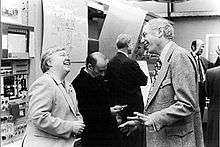Robert G. Sachs
Robert G. Sachs (May 4, 1916 – April 14, 1999) was an American theoretical physicist, a founder and a director of the Argonne National Laboratory.[1][2][3] Sachs was also notable for his work in theoretical nuclear physics, terminal ballistics, and nuclear power reactors.[3][4][4] Sachs was also a member of the National Academy of Sciences,[3] chairman of the Academy's Physics Section,[3] chairman of the Academy's Class I (Physical and Mathematical Sciences),[3] and director of the Enrico Fermi Institute of the University of Chicago.[3][4] Sachs was the author of the standard textbook Nuclear Theory (1953).[3]
Robert G. Sachs | |
|---|---|
 Robert G. Sachs (right) with Atomic Energy Commission chair Dixy Lee Ray. | |
| Born | Robert Green Sachs May 4, 1916 |
| Died | April 14, 1999 (aged 82) |
| Citizenship | United States |
| Alma mater | Johns Hopkins University |
| Known for | nuclear physics, terminal ballistics, and nuclear power reactors |
| Scientific career | |
| Fields | Theoretical physics |
| Institutions | |
| Thesis | Nuclear spins and magnetic moments by the alpha-particle model (1939) |
| Doctoral advisor | Maria Goeppert-Mayer |
| Doctoral students | Gene Amdahl |
| Other notable students | Frederick J. Ernst |
| Influences | Edward Teller |
Notable honors and awards
- Guggenheim fellow[3]
- honorary Ph.D., Purdue University (1967)[3][4]
- elected a member to the National Academy of Sciences (1971)[3]
- honorary Ph.D., University of Illinois (1977)[3]
- honorary Ph.D., Elmhurst College (1987)[3]
Life and career
- Born in Hagerstown, Maryland
- Ph.D. from Johns Hopkins University in 1939
References
- Nagourney, Eric (April 17, 1999). "Robert Sachs, Theoretical Physicist, Dies at 82". The New York Times. Retrieved August 27, 2013.
- "Robert Sachs, Professor Emeritus in Physics, dies at age 82". University of Chicago Chronicle. 18 (15). April 29, 1999. Retrieved 2016-11-09.
- Wali, Kameschwar C. (2004). Robert Green Sachs (PDF). Biographical Memoirs. 84. Washington, D.C.: National Academies Press. pp. 321–346. doi:10.17226/10992. ISBN 978-0-309-08957-9. Retrieved 2016-11-09.
- "Robert Green Sachs – Honorary Degree Recipient". Purdue University. Archived from the original on July 22, 2013. Retrieved August 27, 2013.
Further reading
- Hildebrand, Roger; Winstein, Bruce; Wali, Kameshwar (August 1999). "Robert Green Sachs". Physics Today. American Institute of Physics. 52 (8): 79–81. Bibcode:1999PhT....52h..79H. doi:10.1063/1.882795.
- Kabir, P. K. (May 20, 1988). "Departures from Symmetry". Science. American Association for the Advancement of Science. 240 (4855): 1068–1069. Bibcode:1988Sci...240.1068S. doi:10.1126/science.240.4855.1068. PMID 17731737.
- Snell, Arthur (August 20, 1954). "Book Reviews". Science. AAAS. 120 (3112): 301. Bibcode:1954Sci...120..301G. doi:10.1126/science.120.3112.301-a.
External links
- Robert G. Sachs at the Mathematics Genealogy Project
- Sachs, Robert Green, 1916- at Physics History Network, American Institute of Physics
This article is issued from Wikipedia. The text is licensed under Creative Commons - Attribution - Sharealike. Additional terms may apply for the media files.